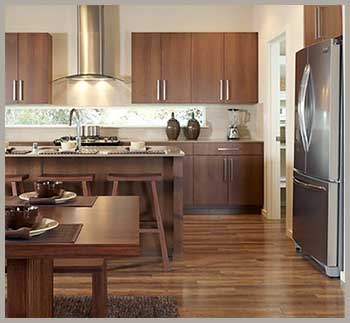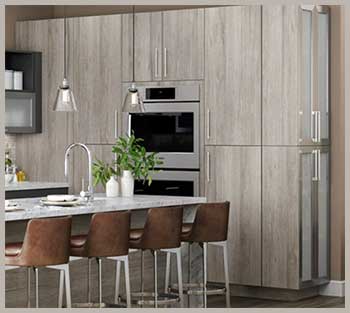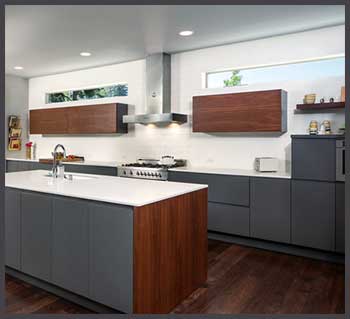I’m standing in my half-renovated kitchen, staring at a pile of cabinet brochures, trying to make sense of it all. My goal? To find the perfect cabinets that balance style, function, and budget.
Bellmont’s 1600 and 1900 series keep popping up in my research, but choosing between them feels like picking a favorite song—each has its own vibe.
This article is my journey to compare these two lines, breaking down their pros, cons, and features to help you make an informed decision for your home.
A Brief Comparison Table
| Feature | Bellmont 1600 Series | Bellmont 1900 Series |
| Price Point | Budget-friendly, entry-level | Mid-range, higher cost |
| Box Construction | 5/8” particle board | 3/4” particle board |
| Drawer Options | 2 (Standard, Satino) | 4 (Standard, Satino, Premium, Elite) |
| Door Styles | 34 options | 70 options |
| Customization | Moderate, semi-custom | High, extensive customization |
| Warranty | Limited Lifetime | Limited Lifetime |
| Style Versatility | Urban, transitional, classic | Modern, contemporary, traditional, transitional |
| Hardware | Soft-close hinges, full-extension drawers | Soft-close hinges, full-extension drawers, more options |
| Eco-Friendliness | Recycled materials, KCMA-certified | Recycled materials, KCMA-certified |
| Best For | Budget-conscious homeowners, apartments | Homeowners seeking premium customization |
My Journey Into Bellmont’s World
When I started my kitchen remodel, I wanted cabinets that would make my space feel like me—functional, stylish, and not a budget-buster. Bellmont kept coming up in conversations with contractors and designers, praised for its frameless, European-inspired designs.
But the 1600 and 1900 series? They sounded like model numbers for a spaceship, not kitchen cabinets. So, I dug in, visited showrooms, and talked to folks who’ve lived with these cabinets.
Here’s what I found, laid out to help you navigate your own cabinet quest.
Understanding Bellmont’s 1600 Series

The 1600 series is Bellmont’s entry-level offering, designed for folks like me who want quality without breaking the bank.
It’s the practical choice, blending affordability with solid construction.
The cabinets are built with 5/8-inch particle board for the box, which is sturdy enough for everyday use but not as beefy as higher-end lines.
The backs are 1/4-inch MDF with 5/8-inch strapping, and the drawers are 1/2-inch birch plywood, dovetailed and edge-banded for durability.
What I love about the 1600 series is its no-nonsense approach. You get soft-close hinges and full-extension drawers as standard, which means no slamming doors or stuck utensils.
With 34 door styles, I could pick from urban, transitional, or classic looks—think sleek flat panels like the Matisse or traditional raised panels like the Heritage. The price is a big draw; for a 10×10 kitchen, I was quoted around $6,000 for a grey flat-panel design, which felt like a steal compared to custom options.
But there’s a catch. The customization is limited. You get two drawer options: Standard and Satino. That’s it. If you’re dreaming of a kitchen with every bell and whistle, you might feel a bit boxed in.
I also heard mixed reviews about quality control. Some folks raved about the durability, while others grumbled about delivery delays or defective parts arriving in worse shape than the originals.
One contractor I spoke with mentioned that the 1600 series is often used for apartments or rental properties, which made me wonder if it’s robust enough for a busy family kitchen.
Pros of the Bellmont 1600 Series
- Affordability: Perfect for budget-conscious folks. My quote was significantly lower than other semi-custom brands like DuraSupreme.
- Solid Features: Soft-close hinges and full-extension drawers are standard, giving you premium functionality at a lower price.
- Eco-Friendly: Made with recycled materials and certified by the Kitchen Cabinet Manufacturers Association (KCMA) for sustainability.
- Versatile Styles: With 34 door styles, you can match urban, transitional, or classic aesthetics.
- Quick Assembly: The modular design makes it easy to replace or upgrade parts, ideal for DIY enthusiasts.
Cons of the Bellmont 1600 Series
- Limited Customization: Only two drawer options and fewer door styles can feel restrictive if you’re after a unique look.
- Thinner Construction: The 5/8-inch particle board is solid but not as robust as thicker materials in premium lines.
- Quality Control Issues: Some users reported inconsistent quality, like veneer peeling or delayed deliveries.
- Entry-Level Perception: Often recommended for apartments, which might not inspire confidence for a forever home.
- Basic Hardware Options: You’re stuck with standard hardware, which might not satisfy those craving high-end touches.
Also Read: Are Barker Cabinets Worth It?
Exploring The Bellmont 1900 Series

Now, let’s talk about the 1900 series—Bellmont’s step-up option that feels like the cooler, more sophisticated sibling.
The first thing I noticed was the thicker 3/4-inch particle board construction, which gives these cabinets a sturdier feel.
The drawers and hardware are the same high-quality, soft-close, full-extension setup as the 1600, but you get four drawer options: Standard, Satino, Premium, and Elite.
This means more flexibility to tailor the cabinets to your needs, whether you want sleek, handle-less drawers or something more robust.
The 1900 series shines in customization. With 70 door styles, I was overwhelmed (in a good way) by choices like the Richmond, a traditional beauty, or the Avant, a modern stunner. You can mix and match textures, finishes, and even add metal-framed glass doors for a chic vibe.
My designer friend called it “the 1900 series dressed in an Italian suit,” and I get why. It’s sleek, versatile, and screams high-end without the custom price tag. For a similar 10×10 kitchen, quotes ranged from $8,500 to $12,000, depending on finishes and add-ons.
But the 1900 series isn’t perfect. The higher price can sting, especially if you’re on a tight budget. I also heard horror stories about delivery issues—parts arriving late or mismatched veneers.
One homeowner I chatted with spent over $50,000 on a 1900 series kitchen and was frustrated by poor customer service when issues arose. Still, most reviews I came across praised the durability and style, especially for those who want a kitchen that stands out.
Pros of the Bellmont 1900 Series
- High Customization: 70 door styles and four drawer options let you create a truly unique kitchen.
- Sturdier Build: The 3/4-inch particle board feels more substantial, ideal for long-term use.
- Premium Features: Options like metal-framed glass doors and creative storage solutions (like the Super Susan for corners) elevate the design.
- Versatile Aesthetics: Covers modern, contemporary, traditional, and transitional styles, fitting any home vibe.
- Eco-Conscious: Like the 1600, it uses sustainable materials and carries KCMA certification.
Cons of the Bellmont 1900 Series
- Higher Cost: Significantly pricier than the 1600 series, which might not fit every budget.
- Delivery Delays: Some users reported long wait times or incomplete shipments, which can derail a remodel.
- Quality Control Concerns: A few complaints about defective parts or mismatched finishes, though less common than with the 1600.
- Overkill for Simple Needs: If you don’t need extensive customization, the extra cost might not be worth it.
- Customer Service Woes: Mixed reviews on support, with some feeling dismissed when issues arise.
Also Read: Are 21st Century Cabinets Worth It?
Key Features That Set Them Apart

Let’s break down the features that make each series unique, because this is where the rubber meets the road.
The 1600 series is all about value.
Its 5/8-inch particle board box is made from recycled materials, which I appreciate as someone who cares about the planet.
The dovetailed birch plywood drawers are a nice touch, and the soft-close hinges make daily use smooth.
I was impressed by the 34 door styles—enough to cover most tastes without overwhelming you.
The modular design also means I could swap out a door or panel if it gets damaged, which is a lifesaver for clumsy folks like me.
The 1900 series, though, is where Bellmont flexes its muscles. The 3/4-inch particle board gives it a premium feel, and the four drawer options let you fine-tune the functionality.
I fell in love with the idea of metal-framed glass doors for my open shelving—perfect for showing off my vintage dishware.
The 70 door styles cover everything from minimalist to ornate, and the storage solutions, like the Super Susan corner unit, make organizing a breeze. Both series carry a limited lifetime warranty, but the 1900 feels like it’s built to last a bit longer.
My Experience Visiting a Showroom
I decided to see these cabinets in person, so I visited a local Bellmont dealer. The 1600 series cabinets felt solid, but the finishes looked a tad basic—great for a clean, simple kitchen but not exactly show-stopping.
The 1900 series, on the other hand, stole the show. The Richmond door in a dark stain had this rich, timeless vibe, while the Avant in high-gloss white screamed modern elegance.
I could see why the 1900 costs more; it’s like comparing a reliable sedan to a sleek sports car. The dealer also showed me the Super Susan, and I was sold on its clever use of corner space.
Installation and Maintenance: What To Expect

Installing Bellmont cabinets is straightforward, thanks to their modular, ready-to-assemble design.
My contractor friend said the 1600 series is a breeze to install, especially for smaller kitchens.
The 1900 series, with its custom options, might require a bit more finesse, but the results are worth it.
Both lines use soft-close hinges, so you won’t deal with annoying slams.
For maintenance, a damp cloth and mild soap do the trick—more on that in the FAQ.
Budget Vs. Dream Kitchen
As I sit in my unfinished kitchen, sipping coffee and staring at my Bellmont brochures, I’m torn. The 1600 series fits my budget and offers solid quality for the price. It’s practical, eco-friendly, and stylish enough for my needs.
But the 1900 series keeps calling my name with its endless options and premium vibe. If I stretch my budget, I could have a kitchen that feels like it belongs in a magazine.
For you, the choice depends on what you value most—saving money or splurging on a custom look.
Also Read: Are UltraCraft Cabinets Worth It?
Frequently Asked Questions (FAQ)
The 1900 series uses 3/4-inch particle board for the box, 1/4-inch MDF backs with 5/8-inch strapping, and 1/2-inch birch plywood drawers. Doors come in various materials like wood, laminate, or veneer.
Bellmont cabinets are made in Sumner, Washington, in a 185,000-square-foot facility using sustainable materials sourced globally.
Use a damp cloth with mild soap to wipe down surfaces. Avoid harsh chemicals or abrasive scrubbers to protect the finish.
Conclusion: Your Kitchen, Your Choice
You’re probably standing in your own kitchen, wondering which Bellmont series is right for you. I get it—it’s a big decision. The 1600 series is your budget-friendly pal, offering solid quality and enough style to make your space shine.
The 1900 series is the dreamier option, with customization that lets you craft a kitchen that’s uniquely yours. Weigh your priorities, consider your budget, and think about how long you’ll live with these cabinets.
For me, it’s a toss-up between practicality and pizzazz, but I’m leaning toward the 1900 for that extra wow factor. What’s your pick?
